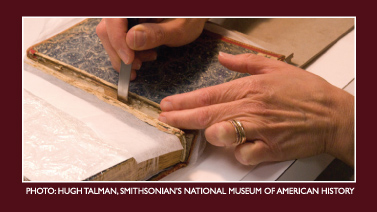Resurrecting Jefferson’s Bible
 Thomas Jefferson was seventy-seven years old in 1820, when he sliced up Bibles in four languages and pasted the passages he liked onto both sides of forty-three sheets of paper, scrapbook-style, then sent those pages to his bookbinder, who created a single leather-bound volume now known as the “Jefferson Bible.”
Thomas Jefferson was seventy-seven years old in 1820, when he sliced up Bibles in four languages and pasted the passages he liked onto both sides of forty-three sheets of paper, scrapbook-style, then sent those pages to his bookbinder, who created a single leather-bound volume now known as the “Jefferson Bible.”
In February 2011, Janice Stagnitto Ellis and a team of Smithsonian conservators began the painstaking process of stabilizing the fragile 191-year-old book before it went on display at the National Museum of American History this past November. First, Ellis’ team analyzed the artifact’s materials, taking microscopic samples from twelve different types of paper and nine different inks.
Ellis subsequently used a special bookbinder’s knife to slice between the leather cover and the Jefferson document inside, keeping the spine and cover intact for later reuse. The nerve-wracking task took six hours, while she eased the tension by playing loud rock music. “It was probably the most stressful day of my adult life,” she says. In the months since, the conservators have separated the book’s pages, mended over a thousand tears and re-secured Bible passages where Jefferson’s old glue had nearly failed. “We’re not trying to improve upon Jefferson or make it a twenty-first century object,” Ellis says. “We’re trying to keep as much historical integrity as possible.”
Conservator Laura Bedford was impressed by the meticulous cut-and-paste job, as well as how finicky Jefferson was when he edited the words in his Bible. She points to a page where he pasted down a passage from the Book of Matthew, chapter 24, verse 38. The original contains the phrase “for as in the days…”
“Apparently, Jefferson didn’t like having three prepositions together, so he cut out the as,” Bedford says. “He was reading the text that closely.”
